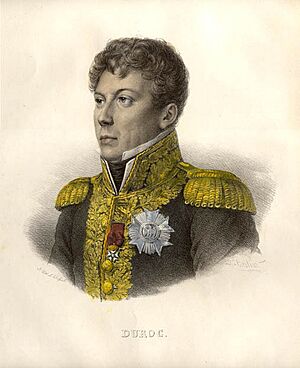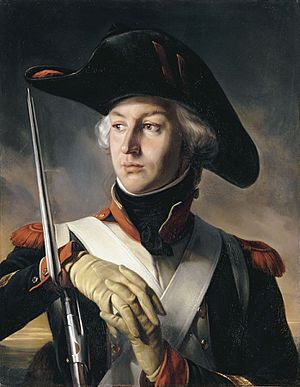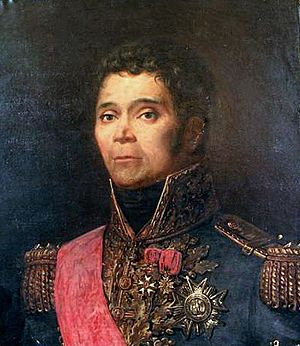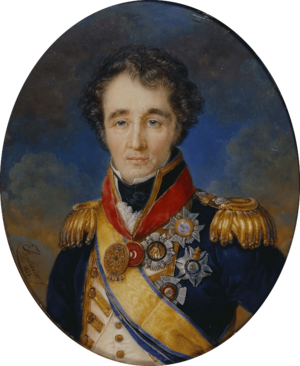Invasion of Portugal (1807) facts for kids
Quick facts for kids Invasion of Portugal (1807) |
|||||||||
|---|---|---|---|---|---|---|---|---|---|
| Part of the Peninsular War | |||||||||
 Detail of the monument dedicated to the heroes of the Peninsular War, Lisbon |
|||||||||
|
|||||||||
| Belligerents | |||||||||
| Commanders and leaders | |||||||||
| Strength | |||||||||
| France: 24,918 Spain: 25,500 Total: 50,418 |
48,396 | ||||||||
| Casualties and losses | |||||||||
| Unknown | Unknown | ||||||||
The invasion of Portugal happened between November 19 and 30, 1807. During this time, French and Spanish armies entered the country. Portugal was led by its Prince Regent, João of Bragança. This military action led to Portugal being taken over. However, the people of Portugal and the United Kingdom fought back in 1808. This invasion was the start of the Peninsular War, which was part of the larger Napoleonic Wars.
France's leader, Napoleon, gave Portugal an ultimatum, which is a final demand. Portugal's government agreed to most of Napoleon's requests. But Napoleon still ordered his general, Jean-Andoche Junot, to invade. Three divisions from Spain helped with the invasion. The Portuguese leaders were too scared and unsure to fight back. Junot took over Lisbon, the capital, on November 30, 1807. But when he arrived, Prince João and many important families had already left. They sailed to Brazil on the Portuguese fleet. The French quickly took control of the whole country. They also took over or broke up the Portuguese army. The next year, the Portuguese people rebelled against the French. The next big event was the Battle of Évora in July 1808.
Contents
Why Did the Invasion Happen?
When the Treaties of Tilsit ended a big war, Emperor Napoleon of France was already annoyed with Portugal. Portugal was still trading with the United Kingdom, which was France's enemy. Napoleon was angry because Portugal was Britain's oldest friend in Europe. Also, Britain was finding new ways to trade with Portugal's colony in Brazil. The British navy often used Lisbon's port to fight against France. Napoleon also wanted to capture Portugal's navy.
Prince John of Braganza was ruling Portugal for his mother, Queen Maria I, who was ill. He had not followed Napoleon's "Continental System." This system was a rule that stopped countries from trading with Britain. Taking over Portugal also fit into Napoleon's plans to take over Spain later.
On July 19, 1807, Napoleon told his ambassador in Portugal to make sure Portugal closed its ports to British ships by September 1. On August 2, a French army group was officially formed, led by General Jean-Andoche Junot. Soon after, France stopped all Portuguese ships in its ports. On September 23, Napoleon made his plans clear. He publicly threatened to remove the Braganza royal family from power.
Meanwhile, on August 12, 1807, French and Spanish ambassadors gave their final demands to the Portuguese Prince Regent. They demanded that John declare war on Great Britain. He also had to let France and Spain use his navy. All British trade in Portuguese ports had to stop, and all British people had to be arrested. John agreed to stop talking to Britain and close his ports. But he refused to arrest British merchants and take their goods. Napoleon thought this was not enough. So, the French and Spanish ambassadors left Portugal on September 30.
On October 12, Junot's army began crossing into Spain. Soon after, France and Spain secretly signed the Treaty of Fontainebleau. This treaty was meant to divide Portugal into three parts. The northern part, including Porto, would become the Kingdom of Northern Lusitania. The southern part would go to a Spanish leader named Godoy. The middle part, around Lisbon, would be controlled by the French. It is likely that Napoleon never planned to follow this treaty. Besides wanting to take Portugal, his real goal might have been to move many French soldiers into Spain. This would make it easier to take over Spain later.
The Armies Involved
French Forces
General Junot was chosen to lead the invasion because he had been France's ambassador to Portugal in 1805. He was known as a good fighter and an active officer. Napoleon promised Junot a special title and a high military rank if he succeeded completely.
Junot's army had 24,918 soldiers. It included one cavalry division and three infantry divisions. The cavalry had 1,754 riders. The infantry divisions had many soldiers, like 7,848 in the 1st Division and 8,481 in the 2nd Division. The 3rd Division had 5,538 men. There were also 1,297 artillerymen and other support staff. Out of the 30,000 men who served in Junot's army, only about 17,000 were experienced soldiers.
Spanish Forces
The Treaty of Fontainebleau said that 25,500 Spanish soldiers would help Junot's invasion. General Taranco led 6,500 troops to take Porto in the north. General Solano led 9,500 soldiers to capture Elvas. General Carrafa led 9,500 men to work with Junot's main army.
Portuguese Forces
The Portuguese army had been updated in 1762. But its management became corrupt. Officers would take money meant for soldiers' pay and supplies. This led to units having fewer soldiers than they should. Cavalrymen often did not have horses, and supply depots were empty.
In 1801, during a short war, the Portuguese army's weaknesses became clear. After that war, they tried to improve the army. They added more battalions to infantry regiments. They also increased the number of soldiers in each company. Cavalry regiments were made larger, and their heavy armor was removed. The number of artillery regiments also increased. The Portuguese army was supposed to have 48,396 soldiers. But because of the ongoing problems, it might have had as few as 20,000 men in 1807.
The Invasion Begins
On November 12, 1807, Junot's army entered Salamanca in western Spain. They had marched about 300 miles (480 km) in 25 days. The French engineers were secretly mapping all fortresses and important points. On that day, Junot received new orders to hurry. The usual invasion route was about 200 miles (320 km) long. But Junot was told to take a shorter route, only 120 miles (190 km) long. Napoleon wanted to speed up the invasion. He was worried Britain might help Portugal, or that Portugal might fight back.
Unfortunately for Junot and his soldiers, the new route went through a wild area. There were few people and very bad roads. Napoleon said, "I will not have the army delayed for a single day. 20,000 men can feed themselves anywhere, even in a desert." The march south was done in five days in cold rain. On this rough road, half of the army's horses died. A quarter of the soldiers got lost, and almost all the cannons were left behind. At Alcántara, Junot took ammunition and food from Spanish troops.
On November 19, 1807, Junot headed for Lisbon. The roads in Portugal were even worse than in Spain. The path along the Tagus valley was just a rough track. It went through a rocky wilderness. The advance group reached Abrantes on November 23. The rest of the army arrived by November 26. By this time, only four Spanish cannons were left with the army. Half of the soldiers were lost or stealing food.

Meanwhile, the Portuguese leaders were in a panic. At first, the Prince Regent thought Napoleon would not really remove him from power. As Napoleon's hostile plans became clearer, John declared war on the United Kingdom on October 20. He also arrested the few remaining British people on November 8. But worrying reports started to arrive in Lisbon about Junot's march. Despite this, John's government did not prepare the Portuguese army to defend the country. Soon after, British Admiral Sidney Smith arrived near Lisbon. He announced that the port was blocked. The British were concerned about a Russian navy group in Lisbon. They also worried that the Portuguese fleet might fall into Napoleon's hands. This would add many warships to the French navy.
Junot met an envoy from the Prince Regent at Abrantes. The diplomat offered to surrender under harsh terms to avoid a French takeover. Junot understood that the Portuguese were helpless. He gathered his best 1,500 men and set out for Lisbon, which was still 75 miles (120 km) away. Without any cannons or cavalry, these French troops struggled into Lisbon on November 30. Their ammunition was wet, and their uniforms were torn. There was no resistance. It took ten days for all of Junot's infantry to arrive. His artillery took even longer. His cavalry immediately started getting new horses from the local people.
The French took Lisbon without a fight. But the royal family had escaped. As Junot's army got closer, the Prince Regent kept changing his mind. He thought about surrendering completely or fleeing to Brazil. Finally, Admiral Smith showed him a French newspaper that said the Braganza royal family had been removed. At this, John decided to escape. He loaded his family, important officials, state papers, and treasure onto the fleet. Many nobles, merchants, and others joined him. With fifteen warships and more than twenty transport ships, the fleet left on November 29. They sailed for the colony of Brazil. The escape was so rushed that fourteen carts full of treasure were left behind on the docks.
Portugal Under Occupation
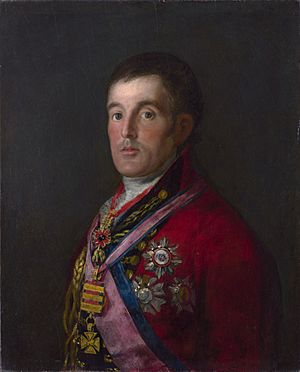
The Spanish army column entered Portugal on December 2, 1807. The Spanish general Taranco took Porto on December 13. The only resistance came from the governor of Valença, who refused to open his gates. He only gave in when he learned that Lisbon had fallen and the Prince Regent had fled. While Portuguese officials generally obeyed the French, the common people were angry. When Junot raised the French flag in Lisbon on December 13, a riot broke out. Soldiers on horseback were sent to break up the crowd by force.
One of Junot's first actions was to break up the Portuguese army. He sent home all soldiers with less than one year or more than six years of service. The remaining soldiers were put into new units. Most were sent to northern Germany for military duty. Two Portuguese units were used by the French in an attack in Spain in August 1808. The Portuguese Legion also fought for France in a battle in July 1809. In 1812, Portuguese troops were reorganized and took part in the French invasion of Russia. Few of these unlucky men survived that campaign.
Junot tried his best to keep his troops under control and calm the situation. However, new orders from Napoleon made his job harder. Junot was told to take the property of the 15,000 people who had fled to Brazil. He also had to demand a huge fine of 100 million francs from Portugal. The people who fled had taken almost half of Portugal's money. The French could barely collect enough money to support their army. Still, the harsh taxes caused great anger among the people. By January 1808, people who resisted the French demands were being executed. The situation was dangerous, but most of the country's leaders had gone to Brazil. This left no one to lead a rebellion.
By the spring of 1808, the French army in Portugal had 25,000 active soldiers. About 4,000 more soldiers had arrived earlier that year. The situation changed after the Spanish Dos de Mayo Uprising. Junot soon found that all communication with Paris was cut off by the Spanish revolt. On June 6, 1808, news of the rebellion reached Porto. General Belesta was there with 6,000 Spanish troops. He captured a French general and his escort. Belesta then marched his troops away to join the armies fighting the French. Between June 9 and 12, northwest Portugal erupted in revolt.
What Happened Next?
The next major event was the Battle of Évora on July 29, 1808.
British help arrived in early August. General Sir Arthur Wellesley and 9,000 soldiers landed in Mondego Bay. This led to the Battle of Roliça and the Battle of Vimeiro.
See also
- Timeline of the Peninsular War
- Secret Convention on the Transfer of the Portuguese monarchy to Brazil


